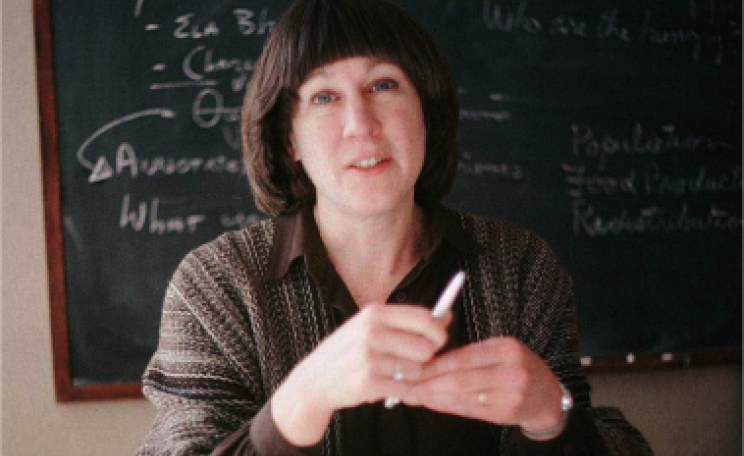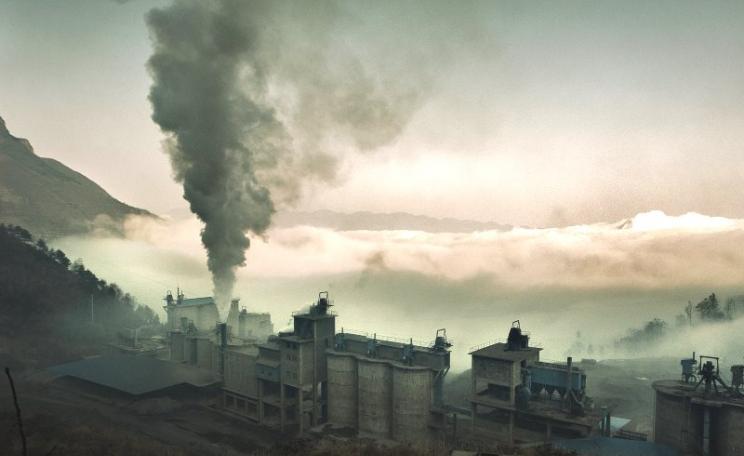Education at all levels – schools, universities and further education – needs to focus on these existential challenges and to assure that biosphere and technosphere are aligned.
“Modern man does not experience himself as a part of Nature but as an outside force destined to dominate and conquer it. He even talks of a battle with Nature, forgetting that, if he won the battle, he would find himself on the losing side.” – E.F. Schumacher, Small Is Beautiful
We need bold solutions to an existential problem: humans have become an immensely powerful planetary force, and after millennia of modest Nature-focused ways of living, humanity has morphed into an urban-industrial giant seeking to unshackle from Nature’s embrace. But our remorseless interventions in the world’s ecosystems are threatening our own future existence. Can we still change course?
Support the continued publication of the Megamorphosis series by donating now.
The ever-growing global environment movement is doing its best to try and stem damage to forests, soils and oceans, and yet the destruction continues. Why is this?

This essay proposes that we are faced with a profound problem of perception. Our education system has yet to convey a clear understanding of the special properties of life: we are barely addressing the systemic clash between modern humans and Nature, between technosphere and biosphere: the deep-seated ecological problems we face need to be vigorously addressed in the content of our education and communication systems.
We need to ensure that young people, whose very future is at stake, are equipped with the know-how to address these vital issues. Much of our education system is focused on providing students with narrow perspectives, supposedly enabling them to get a stake in a prosperous future for themselves. More than ever before they need clear perspectives on how we can live in unison with life on Earth. Faced with a planetary emergency, is deep ecological transformation, a ‘megamorphosis’ of modern society, still a possibility? What can education contribute?
The biosphere
All life, including human life, ultimately depends on the wellbeing of our host planet as a vast, interconnected, synergistic system. The great naturalist Alexander von Humboldt, drawing on his extensive travels and inspired by German philosopher Friedrich Wilhelm Joseph Schelling’s Naturphilosophie, called the Earth a “wonderful web of organic life”. In his internationally best-selling Kosmos series of books, he was a pioneer of an ecological worldview: “Nature is a living whole, not a dead aggregate,” he wrote in 1845.
Education at all levels – schools, universities and further education – needs to focus on these existential challenges and to assure that biosphere and technosphere are aligned.
It was the famed Austrian geologist Eduard Suess who named the space on Earth that contains life, including human life, the biosphere. In 1875 he wrote: “The plant, whose deep roots plunge into the soil to feed, and which at the same time rises into the air to breathe, is a good illustration of organic life, interacting between the upper sphere and the lithosphere. On the surface of continents it is possible to single out an independent biosphere.”
This concept was revisited in 1926 by Russian Ukrainian biochemist Vladimir Vernadsky when he published his book The Biosphere, focused on the interaction between planetary biology, chemistry and geology. He says: “The biosphere is the only region of the Earth’s crust where life is to be found… Without life, the face of the Earth would become as motionless and inert as the face of the moon.” The term ‘biosphere’ is now familiar as the place where photosynthesis, powered by the sun’s energy, reigns supreme.
The biosphere is a profoundly dynamic place, with a vast variety of living organisms interacting with one another. Most traditional cultures and some modern thinkers have recognised a vital force being present in Nature, but this very notion is being refuted by much of contemporary science. In 1988, the evolutionary biologist Ernst Mayr wrote: “Vitalism has become so disreputable a belief in the last fifty years that no biologist alive today would want to be classified as a vitalist.”
Perhaps the word ‘vitality’ might be a less contentious term to describe the dynamic forces present in Nature. Unlike non-living things, living organisms have the capacity to reproduce and to grow. They are made up of cells that divide and develop into distinct organisms, seeking out organic matter as food. They interact and communicate with one another, and adapt to the world around them.
Vitality, of course, is also closely twinned with mortality, as all living organisms die sooner or later, but crucially death is also the basis of new growth and new life. Nature, in its vast variety and abundance, is an essentially circular system, with continuity of life a key, systemic feature.
In 1979, James Lovelock, in his book Gaia: A New Look at Life on Earth, had his own take on this perspective, boldly arguing that “life (itself) maintained the stability of the natural environment, and that this stability enabled life to continue to exist.” His work stimulated the emergence of Earth systems science, focused on both the interlocking cycles of Nature and the human interactions with it, but this new, multidisciplinary way of viewing our home planet hardly features in our education curricula.
Gaia theory has given rise to a new ‘Earth consciousness’, at a time when the relationship between humans and our home planet is becoming ever more precarious. Lovelock was deeply concerned that humanity, whilst being part of the Gaian system, was nevertheless a profoundly destabilising force vis-à-vis life on Earth, particularly regarding our reckless use of fossil fuels. He pointed to the ever-rising CO2 concentrations in the Earth’s atmosphere, increasing from 290ppm to 420ppm during his lifetime. He saw it as crucially important for Earth consciousness to become deeply embedded in education to help us develop a holistic relationship between people and planet.
Changes in biomass
Earth consciousness is of critical importance at a time when human impacts on the biosphere have reached unprecedented proportions. A study recently published by Ron Milo of the Weizmann Institute in Israel investigates the impacts of modern humanity on the biosphere and the astonishing changes that have occurred. He found that human activities have reduced the biomass of wild marine and terrestrial mammals by more than 80 per cent, and the biomass of plant matter by 50 per cent. Farmed poultry today makes up 70 per cent of all birds on the planet, and just 30 per cent of birds are wild. Farmed animals, mostly cattle and pigs, comprise 60 per cent of all mammals on Earth, 36 per cent of mammals are human, and just four per cent are wild. Today eight billion people equipped with a vast array of new extractive technologies outstrips the Earth’s annual renewable resources budget. “I would hope this gives people a perspective on the very dominant role that humanity now plays on Earth,” Milo told The Guardian.
Faced with a climate and biodiversity emergency, it has never been more important for all of us to develop a comprehensive understanding of the vast web of life, using Earth consciousness, or what Fritjof Capra calls ‘eco-literacy’, as our frame of reference. Capra emphasises that we need to refocus from biology and the study of single organisms to the wider realm of ecology and the complexity of species interaction.
Support the continued publication of the Megamorphosis series by donating now.
This also requires us to get a clear view of the difference between living systems and inanimate matter. According to quantum physicist Erwin Schrödinger, “Life seems to be orderly and lawful behaviour of matter, not based exclusively on its tendency to go over from order to disorder, but based partly on existing order that is kept up… We must be prepared to find a new type of physical law prevailing in it… From all we have learnt about the structure of living matter, we must be prepared to find it working in a manner that cannot be reduced to the ordinary laws of physics.”
This view was shared by Ludwig von Bertalanffy, the inventor of general system theory. He proposed that the classical laws of thermodynamics might be appropriate to closed systems, but not necessarily to open systems such as living things: “The conventional formulations of physics are, in principle, inapplicable to the living organism being open systems having a steady state. We may well suspect that many characteristics of living systems which are paradoxical in view of the laws of physics are a consequence of this fact.”
Rainforest ecosystems demonstrate these properties of life most vividly. Their canopies, directly exposed to sunlight, are harbingers of Earthly abundance. As their leaves, fruits and nuts fall to the ground, they also enrich life on the forest floor, of low-growing vegetation, and of fungi and invertebrates.
Importantly, all the multiple leaf layers of a forest add up to a surface area many times larger than the soil surface on which the forest stands, a fact that is barely reported. With deforestation, a landscape’s bioactive surface is greatly reduced, and photosynthesis, and thus the production of oxygen, is invariably compromised. Similarly, in the oceans, loss of seagrass meadows, kelp and mangrove forests compromises the health of the biosphere.
Nature’s reproductive systems are extremely good at reprocessing the materials they are made of, and this capacity has enabled them to persist on Earth for billions of years. Since all its waste products become sources of new growth, every output by an organism is also an input that renews the living environment, assuring the continuity of life.
The circular, solar-powered reproduction processes found in Nature are systemically different from the linear industrial production processes, mostly powered by fossil fuels, that characterise technical systems. Can we reorganise our technical systems to try and mimic Nature’s living systems?
The technosphere
For most of our existence we lived as hunter-gatherers and subsistence farmers, small in number. While we were utilising a very limited range of hand and hunting tools, our impact on the biosphere was very limited. The solar-powered human economy was essentially circular, with organic wastes key to ensuring future harvests.
By contrast, the technosphere, a product of the Industrial Revolution, is primarily powered by fossil energy sources, or stored ancient sunshine, with ‘progress’ enabled by relentless advances in technology and innovative production systems.
The term ‘technosphere’ was first coined in 1968 by the Vancouver-based control engineer John Milsum. It comprises all the structures and processes that modern humans have imposed on the planet, such as factory production, building technology, transport and communication systems, mechanised farming, cities and megacities.
The technosphere, of course, has enabled a life of abundance for a minority of the world’s population, whilst a majority is still waiting to benefit. But there is another profoundly systemic problem: today the vastly expanded human economy is essentially linear: materials are extracted and turned into consumer products, and wastes are discharged into Nature as pollutants. In our accountancy systems, these environmental externalities are largely unaccounted for, with dire consequences for future life.
The technosphere may be an offshoot of the biosphere, but by contrast it is inanimate and profoundly lifeless. As a linear system, it operates according to its own entropy-driven dynamics. Its products do not grow in some organic process, but rather are assembled on conveyor belts. It has no sense of ‘future’. Crucially, our industrial economies are subject to the second law of thermodynamics: their use of fossil energy, their key characteristic, is an irreversible process, with materials degraded and usable energy irretrievably turned into unusable, dispersed waste. Recycling is often avoided because of costs that both producers and consumers are unwilling to pay.
Support the continued publication of the Megamorphosis series by donating now.
Anthropomass
Another study from the Weizmann Institute of Science, by Emily Elhacham et al., published in Nature in December 2020, reveals the following:
The stuff we make, called anthropogenic mass or ‘anthropomass’, added up to some 35 billion tonnes in 1900, doubling by 1950. It increased again, to about half a trillion tonnes, by 2000. By 2020 it had doubled again, to be equivalent to the mass of all living things.
In 1900, anthropomass equalled about three per cent of the total biomass. By 2000, this number had grown to 100 per cent, with the number of humans quadrupling in this time frame. Today, for every person alive, a quantity of anthropomass greater than their body weight is produced every week.
Under current trends, the products of the technosphere will outweigh the living world by as much as threefold by 2040. The number of new ‘technospecies’ coming out of our factories and laboratories now far exceeds the Earth’s estimated nine million living species. Concrete and aggregates make up four-fifths of the total, followed by bricks, asphalt and metals, not counting rock used in building construction or generated in mining. In total we use and discard some 30 trillion tonnes of Earth’s resources every year. Whilst plastics are a minor ingredient, their mass is greater now than that of all animals on Earth.
Since the 1950s, the Earth has been on a new, human-driven trajectory – leaving behind the stable conditions of the Holocene epoch, and entering the uncertain new world of the Anthropocene.
Urbanisation, now on an unprecedented scale, is a major contributor to the systemic clash between biosphere and technosphere. As cities expand geographically, they encroach on the realms of the biosphere, usurping ever-larger living landscapes and paving them over with tarmac and concrete. This has robbed vast areas of land of the capacity to photosynthesise.
Well over half the world’s population now lives in cities and megacities, mostly located on the world’s coastlines and river valleys, on former forest and farmland soil. Our urban lifestyles increasingly draw on resources brought in from long distances – water, food, energy, metals and aggregates – the global ecological footprints of cities, often extending to hundreds of times their actual built-up surface area. Order, imposed on landscapes in geometric urban settlement patterns, causes disorder elsewhere in Nature as products are imported, utilised, and discarded.
Cities are also giant heat engines – but there is the catch: the fossil fuel energy they utilise for their many vital functions can be used only once, as fuels combust into low-grade heat and waste gases. And as urban factories process materials into products, quality inevitably starts to deteriorate. High-energy modern cities will therefore tend to contribute to disorder, waste and pollution.
Thus modern cities, and their technology-driven economies, could be described as ‘entropy accelerators’ – continuously downgrading the resources they require in the process of using them. A key question that needs an urgent answer: how can we rapidly replace high-entropy urban energy and production systems with low-entropy, renewable energy and (re)production systems?
Cities are places where human creativity reigns supreme and now the task is to use eco-literacy as a tool for change. To assure our future viability, our education systems need to address the gap between the prevailing linearity of technical systems and Nature’s circular ecological systems.
Circular technical systems?
To try and align technosphere and biosphere, then, is a historic challenge in this age of the Anthropocene. To take stock of what it could mean for education it might be useful to summarise the profound systemic difference between biosphere and technosphere:
- The biosphere, driven by solar energy and photosynthesis, is an essentially circular system, which is all about reproduction: organic growth, regeneration, species interdependence and communication. All wastes are recycled into new growth, assuring the continuity of life.
- The technosphere, largely powered by fossil fuel combustion, is an essentially linear system. It is defined by production: resource extraction, mechanical assembly, chemical manipulation, and linear waste disposal, with pollution systemically undermining the continuity of life.
E.F. Schumacher put it succinctly: “The system of Nature, of which man is a part, tends to be self-balancing, self-adjusting, self-cleansing. Not so with technology.”
We need to get to grips with the fact that the technosphere, in its current form, clashes with the functional principles of the biosphere, an organic, ecologically defined system. The second law of thermodynamics tells us that the processes at work in the technosphere are defined by entropy – erosion of quality. By contrast, in the biosphere negentropy – or sustained order – prevails.
As regards energy, dramatic change is inevitable: every year we currently burn at least one million years’ worth of fossil fuel deposits, accumulated in the Earth’s crust over some 300 million years. In this climate-challenged world, how can this possibly remain the energy basis of human civilisation?
Burning the world’s remaining fossil fuel reserves would unleash 3.5 trillion tonnes of greenhouse gas emissions – seven times the remaining carbon budget to cap global heating at 1.5 degrees Celsius – according to the first public inventory of hydrocarbons, published in September 2022. The UN’s annual Production Gap assessment in 2021 found that governments plan to burn more than twice the fossil fuels by 2030 that would be consistent with a 1.5-degree Celsius world.
It seems only too evident that modern fossil-fuel-powered technical systems face redundancy. Switching rapidly to efficient use of renewable energy is the logical, inevitable next step, despite resistance from entrenched interests. But as the costs of renewable energy have been coming down dramatically in recent years, this is becoming more plausible all the time.
To have any long-term viability, our civilisation needs to learn to live within the capacity of natural systems to renew themselves. Food production can only be viable in the long term as a circular system. Across the world, there are now many permaculture, agroforestry and biodynamic farming systems that practise these methods, and conveying this knowledge to students should be an important part of school curricula.
Moving production and consumption practices towards circularity is vitally important, but systems change in that direction is a hard nut to crack, since the technosphere does not have the inherent capacity to continually renew itself in the same way as the biosphere.
That is where human inventiveness needs to come into play. There is much talk now about creating circular ‘cradle to cradle’ economies. This concept goes beyond the waste management mantra of refusing, reducing, recycling and remanufacturing, which has long been on the green agenda. We need to be clear that much recycling, as currently practised, is actually down-cycling.
The redesign of the ‘technical metabolism’ is a vital task. Circular systems for technical materials – particularly plastics and clothes fabrics – are crucial for future viability. Most of us are only too aware now of the horrendous scale of plastics pollution in rivers, lakes and oceans, and its impacts on Nature. The main challenge is to reinvent industrial production systems that mimic Nature’s metabolism.
This is where the work of pioneering eco-industrial designers Michael Braungart and Bill McDonough is particularly important: “There are three basic principles of Cradle to Cradle Design: waste equals food, use current solar income, respect diversity. These principles allow Cradle to Cradle Design to conceive industrial systems that emulate the healthy abundance of Nature.”
Plenty of literature is now available for students at all levels to explore these options and to study examples of real-life practices.
The noosphere and the internet
Back to Vladimir Vernadsky and his book The Biosphere: jointly with French theologian and philosopher Teilhard de Chardin, Vernadsky pioneered, in 1922, the concept of the noosphere, described as the “planetary sphere of reason”. In summary: “The noosphere represents the highest stage of biospheric development, its defining factor being the development of humankind’s rational activities.”
In ancient Greek, noos is a word for ‘mind’ or ‘reason’. The idea of a knowledge-dispersing noosphere is barely known 100 years after it was first publicised. But the recent rapid growth of cyberspace – the realm of the internet – could be said to resemble or even represent this noosphere, disseminating Earth consciousness/eco-literacy. At best, the internet and global communications can be key educational tools for overcoming the evident mismatch between biosphere and technosphere.
It is certainly true that the internet enables unprecedented access to information, to knowledge, and even to sources of wisdom. So far, so good. But it is also being increasingly usurped by commercial interests as a tool of a new global ‘surveillance economy’. In the face of this, every possible effort should be made to build up distinct sections of the internet as vital tools for disseminating knowledge of the workings of our home planet.
In a time of planetary emergency, education cannot be focused only on young people. With little time left to prevent the Earth from overheating and disastrous biodiversity loss, rapid decisions are needed to overcome the systemic conflicts between biosphere and technosphere. All of us, including decision makers of every description, have to undergo crash courses in Earth systems science.
Concepts and practices for enabling the regeneration of the Earth’s living, organic economy should be at the heart of education, focused single-mindedly on long-term wellbeing of people and planet. The need to reinvigorate the vital organs of our home planet must be closely linked to exploring ways and means to lead less demanding, simpler lives.
The growth of the eco-technical revolution and the green new deal now under way might be a significant step in the right direction, but, in the rush towards mainstreaming renewable energy and electric transportation, can we avoid systemic dependence on metals such as lithium, as well as cobalt, coltan and copper, which are mostly mined by slave labour in places previously covered in forest ecosystems?
Support the continued publication of the Megamorphosis series by donating now.
Nature as teacher
As we face an unprecedented emergency on planet Earth, Nature, as a vast, multifaceted, interactive living system, needs to be our revered teacher: it is all about give and take, in an exuberant dance of life, powered by sunlight and wetted by rain. Until we learn to adopt Nature’s ‘circular’ ways, always giving back what we have borrowed, we will deplete her resources to a point where human life itself is in question.
Our education system needs to convey plausible ways and means of restoring the Earth’s living, organic economy. Wherever possible this should not be book learning but experience-based, hands-on learning – in gardens and orchards near people’s homes, and in wide-open landscapes. There are many studies that show that spending time out and about in Nature is good for our wellbeing.
Back in the classroom and at home, a plethora of documentaries about the wonders of life on Earth are there for us to view and enjoy. Animations are particularly well suited to portraying the complex interconnections of the Earth’s systems and cycles.
Beyond this, we have other amazing new tools available to us to glean new, global perspectives. Using satellite technology (also a product of the technosphere), we can see the Earth from space, in all its astonishing variety, and scrutinise the changes that are occurring on the landscapes and seascapes of our home planet. And we can now see the world for ourselves as never before: at night, much of the Earth is now illuminated by billions of lights from households, public buildings, and vehicles. The lights of cities and the flares of oil and gas fields are turning night into artificial day. These images vividly illustrate the unprecedented human presence on Earth.
Then, during daylight hours, we can see straight lines and right angles stretching across vast landscapes. Cities with their angular building blocks and multi-lane highways are much in evidence in many places, mostly located in coastal areas and along rivers.
In other areas we see vast fields used for large-scale mechanised agriculture, often sprawling across former forest landscapes. In some places there are feedlots with tens of thousands of cattle crammed together behind impenetrable fences. Elsewhere, large numbers of green circles are densely clustered together – the patterns of irrigated crops imposed on otherwise barren landscapes. These are the ecological footprints of an urbanising world.
Cities in one part of the planet are umbilically linked to distant farmland, forests and mines to slake their insatiable appetite for resources. To convey an understanding of these global ‘teleconnections’ is an important task for education at all levels, junior education and university tuition, as well as further education and lifelong learning.
The total extent of the Earth’s surface is listed in atlases as 51 billion hectares, of which 71 per cent is ocean and 29 per cent land surfaces. Agriculture utilises half that land, with forests now covering 30 per cent. There are approximately three trillion trees in the world. Over 15 billion are cut down each year, and the global number of trees has fallen by almost half since the start of human civilisation.
But these figures do not convey the full picture. Importantly, they do not account for the fact that the planet’s three-dimensional living surfaces – tree canopies and scrub vegetation – extend to a vastly larger area than its registered surface area.
Walking in a rainforest, and looking up at its multi-layered canopy, it is obvious that its leaf surface is many times larger than the surface area of the forest floor. Precise estimates are still not available.
The Gaia theory states that the composition of the Earth’s atmosphere is kept in a dynamically steady state by the presence of life, assuring its continuity. Large-scale deforestation, as has been occurring across the tropics, in South America, Africa and Asia, ominously interferes with this capacity.
With rapid loss of tropical forest cover and marine vegetation in many places, the Earth’s bioactive surfaces are being continuously reduced. This is particularly troubling at a time when biological carbon sequestration is more important than ever, with only half of our CO2 emissions currently being absorbed by photosynthesis. Most alarmingly, rainforests, vital organs of planet Earth, are well on their way to becoming net emitters of CO2.
The degree to which deforestation has caused the loss of vast layers of living vegetation has barely been estimated. The ever-growing demands of the technosphere as it currently operates undermine the very capacity of the biosphere to absorb our discharges, whilst also interfering with the Earth’s water, nutrient and carbon cycles.
It is becoming increasingly apparent that much of economic growth across the world, based on depleting the integrity of the biosphere, has effectively become uneconomic growth: deforestation, resource depletion, pollution and climate breakdown inevitably damage the relationship between people and planet. Prevailing economic theory and practices are clearly failing much of humanity. It is vital for our education system to convey this reality and to envisage alternatives.
It is crystal clear that the systemic principles underpinning the Industrial Revolution, which gave rise to the technosphere, are now redundant: we need to address the fact that our industrially empowered economic system puts economy before ecology, largely ignoring critical environmental externalities.
Education at all levels – schools, universities and further education – needs to focus on these existential challenges and to assure that biosphere and technosphere are aligned, both theoretically and practically. Across the world we can build a vibrant new green economy, with new livelihoods for billions of people. Let’s get on with it.
This Author
Professor Herbert Girardet is a co-founder of the World Future Council, and a member of The Club of Rome. His most recent book is Creating Regenerative Cities (Routledge). Professor Girardet is also a trustee at the Resurgence Trust, which owns and publishes The Ecologist. You can download a free PDF of this essay. Support the continued publication of the Megamorphosis series by donating now.





